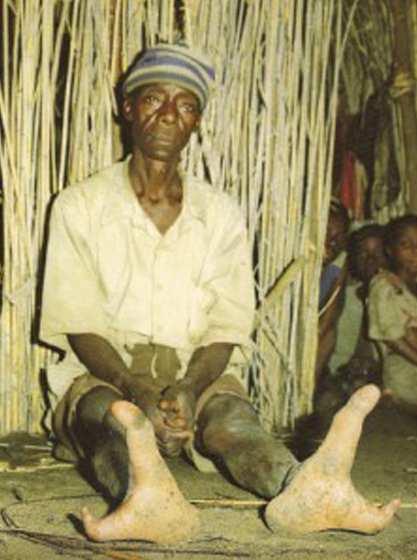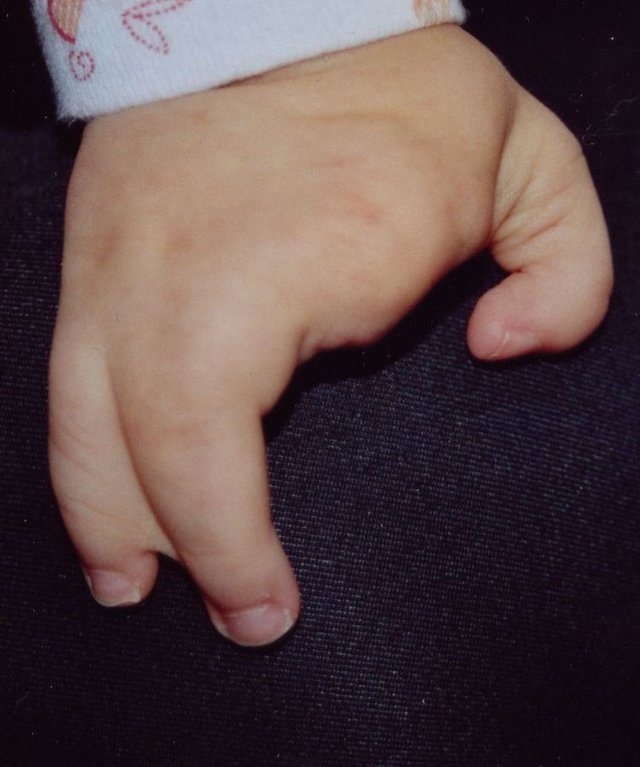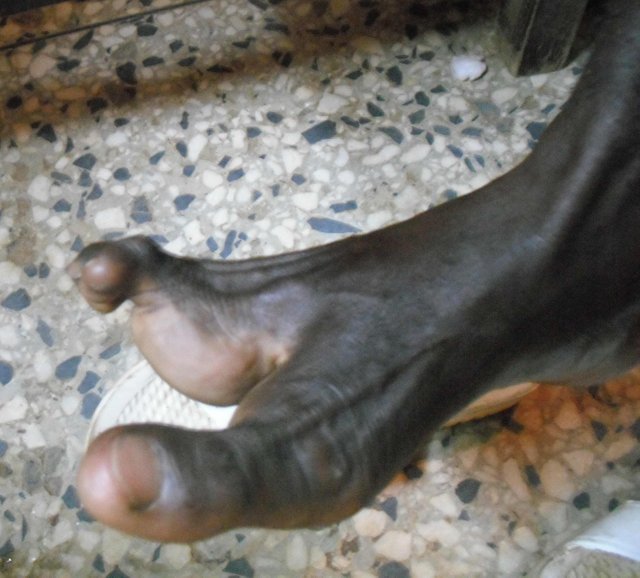The Ostrich People of Zimbabwe
The Doma or vaDoma (singular muDoma), also known as Dema, are a tribe living in the Kanyemba region in the north of Zimbabwe, especially in the Urungwe and Sipolilo districts around the basins of Mwazamutanda River, a tributary of the Zambezi River Valley. They are the only traditional hunter-gatherers indigenous to Zimbabwe and famous for the inherited genetics existing among some vaDoma families.
Image credits
This genetic condition is called ectrodactyly. The foot is missing the three middle toes and the two outer ones are turned in, which is why the Vadoma people are also called the "two-toed" tribe. The foot itself is said to resemble that of an ostrich’s foot, thus the name, ostrich people. Ectrodactyly is an autosomal dominant condition which is the result of a single mutation on the number seven chromosome.
History
Historically, the vaDoma chiefly dwelt in the mountains, living a largely nomadic lifestyle of hunting, fishing, trapping, honey hunting, and gathering wild fruits and roots. Prior to the European colonization of Africa, the vaDoma also resisted incorporation into the Korekore Shona kingdom of Mutapa, which resulted in little access to fertile land. Land reform after Zimbabwe's independence did not change this, despite pressure from the Mugabe government, and the vaDoma's continuing dispossession has made them Zimbabwe's only non-agricultural society, leading to stereotypes as "Stone Age cave-dwellers".
| 1 | 2 |
|---|---|
 | |
| Image credits | Image credits |
According to vaDoma mythology, their ancestors emerged from a baobab tree. Upon descending from it, they walked upright to hunt and gather the fruits of the land. The name vaDoma is also used in the Zambezi region for a semi-mythical people characterized as magical, capricious, hard to find, and living among the trees. Rumors also persist among nearby peoples that the vaDoma are capable of disappearing in the forest and performing magic.
Ectrodactyly.
(Also known as a split hand, cleft hand or lobster claw hand) derived from the Greek ektroma (abortion) and daktylos (finger) is a skeletal anomaly predominantly affecting the hands (although the feet can also be affected). The condition has a highly variable severity. It involves the deficiency or absence of one or more central digits of the hand or foot and is also known as split hand/split foot malformation (SHFM). The hands and feet of people with ectrodactyly are often described as "claw-like" and may include only the thumb and one finger (usually either the little finger, ring finger, or a syndactyly of the two) with similar abnormalities of the feet.

Ectrodactyly on the hand of a one-year-old child
Image credits
It is a rare form of a congenital disorder in which the development of the hand is disturbed. The central ray of the hand is affected and usually appears without proximal deficiencies of nerves, vessels, tendons, muscles and bones in contrast to the radial and ulnar deficiencies. The cleft hand appears as a V-shaped cleft situated in the centre of the hand. The digits at the borders of the cleft might be syndactilyzed, and one or more digits can be absent. In most types, the thumb, ring finger and little finger are the less affected parts of the hand. The incidence of cleft hand varies from 1 in 90,000 to 1 in 10,000 births depending on the used classification.
Genetics
The most common mode of transmission is as a autosomal dominant trait and has a variable penetrance of 70%. Cleft hand can be a spontaneous mutation during pregnancy. although autosomal recessive and X-linked modes of transmission also have been described. The exact chromosomal defect in isolated cleft hand is not yet defined. However, the genetic causes of cleft hand related to syndromes have more clarity.
Image credits
Epidemiology)
The estimated incidence is at ~ 1 in 90,000 - 150,000 births
Pathology
It results from a longitudinal deficiency in central digits where the mechanism is thought to be a failure of the median apical ectodermal ridge in the developing limb bud.
##Associations
*SYNDROMIC
Karsch-Neugebauer syndrome
Roberts syndrome
EEC syndrome (ectrodactyly-ectrodermal dysplasia-clefting syndrome)
ectrodactyly
ectodermal dysplasia
cleft lip or palate
*NON SYNDROMIC
syndactyly, aplasia, or hypoplasia of the residual phalanges / metacarpals sensorineural hearing loss
Classification
There are several classifications for cleft hand, but the most used classification is described by Manske and Halikis. This classification is based on the first web space. The first web space is the space between the thumb and the index. The table below shows the classification of cleft hand.
| TYPE | DESCRIPTION | CHARACTERISTICS |
|---|---|---|
| ........ | ...................... | ............................ |
| I | Normal web | Thumb web space not narrowed |
| IIA | Mildly narrowed web | Thumb web space mildly narrowed |
| IIB | Severely narrowed web | Thumb web space severely narrowed |
| III | Syndactylized web | Thumb and index rays syndactylized, web space obliterated |
| IV | Merged web | Index ray suppressed, thumb web space is merged with the cleft |
| V | Absent web | Thumb elements suppressed, ulnar rays remain, thumb web space no longer present |
This brings us back to the Kanyemba region in the north of Zimbabwe
Propagation of Ectrodactyly in this region.
Due to the vaDoma tribe's isolation, they have developed and maintained ectrodactyly, and their comparatively small gene pool has resulted in the condition being much more frequent than elsewhere.
Prior to the European colonization of Africa, the vaDoma also resisted incorporation into the Korekore Shona kingdom of Mutapa, which resulted in little access to fertile land. Land reform after Zimbabwe's independence did not change this, despite pressure from the Mugabe government, and the vaDoma's continuing dispossession has made them Zimbabwe's only non-agricultural society, leading to stereotypes as "Stone Age cave-dwellers".
The condition prevails because of a small genetic pool among the vaDoma and is propagated by the tribal law that forbids members to marry outside the group.There are many in their community, who can't wear shoes due to the shape of their feet. They only have two big toes on each foot.
They don't have middle toes and the two outer ones are turned in. They still can walk but with some difficulty according to the shape, running is also difficult to them. It is said this condition helps them while climbing trees, though. The elders of the Vadoma people claim that their remote ancestors were bird like beings who came from the stars and mixed their DNA with early earth women to produce offspring. The elders state that their ancient ancestors came from the star systems of Sirius and first established colonies on a planet within our solar system that they refer to as Liitolafisi.
Hope.
Now here comes the BIG question.
Is there any hope for the people of Kanyemba region in the north of Zimbabwe??
ANSWER
YES
Treatment
The treatment of cleft hand is usually invasive and can differ each time because of the heterogeneity of the condition. The function of a cleft hand is mostly not restricted, yet improving the function is one of the goals when the thumb or first webspace is absent.
Indications
Surgical treatment of the cleft hand is based on several indications:
Improving function
Absent thumb
Deforming syndactyly (mostly between digits of unequal length like index and thumb)
Transverse bones (this will progress the deformity; growth of these bones will widen the cleft)
Narrowed first webspace
The feet
Aesthetical aspects
Reducing deformity
Classification and treatment
When surgery is indicated, the choice of treatment is based on the classification. The table below shows the treatment of cleft hand divided into the classification of Manske and Halikis. Techniques described by Ueba, Miura and Komada and the procedure of Snow-Littler are guidelines; since clinical and anatomical presentation within the types differ, the actual treatment is based on the individual abnormality.
| TYPE | TREATMENT |
|---|---|
| I/IIA | Reconstruction of the transverse metacarpal ligament |
| IIB/III | Transposition of the index metacarpal with reconstruction of the thumb webspace |
| IV | Mobility and/or position of the thumb of ulnar digit to promote pinch and grasp |
| V | There is no cleft or web space and the thumb is very deficient. This hand requires consideration of creating a radial digit |
Way Forward.
- The people of Kanyemba region should be Educated on a whole lot which includes preventive measures and medications after a child have been born with this illness.
Someone once said and i quote "But come to think of it, the reason they can't wear shoes is not because of the shape of their feet, but because of the size of their brains. Why can't they just make specialized shoes and other footwears to fit their feet?" Source
Considering the fact that this persons get little or no education it could be said that Education will go a long way helping their situation.
The people should be encouraged to socialize with other regions. This would serve as a preventive measure against ectrodactyly as it have been noticed that this illness is propagated by the tribal law that forbids members to marry outside the group.
I think the Government and other NGOs should actively participate it helping these people with funds because we all know the treatment is real huge considering the fact we know the are just hunters who can raise funds for the treatment.
Source 1
Source 2
Source 3
Source 4
Source 5
If this post inspired, motivate, or educate you, why not follow and resteem so others can experience same? If you could upvote as well I will be glad and your comment will make me believe you did one of the three.



Wow great facts not all of us Know about ectrodactyly.
Nice work @arcjen02. Thanks for sharing.
Followed and resteemed.
Downvoting a post can decrease pending rewards and make it less visible. Common reasons:
Submit
hi. i want to leave a comment because this is an interesting article. however many parts of it are not your own words. When you copy things word for word out of another article its considered plagiarism. People will not vote your posts for this. Also, many of the photos you used were from the articles of other people. This is also not correct, because those people might have copyright privileges. Even if the images are free to use, you must say where each image comes from and whose permission you have to use them. I give you much credit because you did put together a lot of research. I suggest you learn the correct way to create an article with sourcing and citations. Best of luck.
Downvoting a post can decrease pending rewards and make it less visible. Common reasons:
Submit
Thanks a bunch @torico I really do appreciate your comment and advice. I hope to improve as i grow.
Downvoting a post can decrease pending rewards and make it less visible. Common reasons:
Submit
i am sure it will. there are many articles that can help you to write. if you are looking for any subject in particular let me know i can send you links.
Downvoting a post can decrease pending rewards and make it less visible. Common reasons:
Submit
This post received a 38% upvote from @morwhale team thanks to @factshub! For more information, click here! , TeamMorocco! .
Downvoting a post can decrease pending rewards and make it less visible. Common reasons:
Submit
Congratulations @arcjen02! You have completed some achievement on Steemit and have been rewarded with new badge(s) :
Click on any badge to view your own Board of Honor on SteemitBoard.
For more information about SteemitBoard, click here
If you no longer want to receive notifications, reply to this comment with the word
STOPDownvoting a post can decrease pending rewards and make it less visible. Common reasons:
Submit
As the other user stated, copying text from a source is still considered plagiarism, since there are no quotations and no original content.
In the future make sure to quote any writing that is not your own, or you risk being blacklisted from the likes of us at steemSTEM, or worse, steemcleaners.
Good luck
Downvoting a post can decrease pending rewards and make it less visible. Common reasons:
Submit